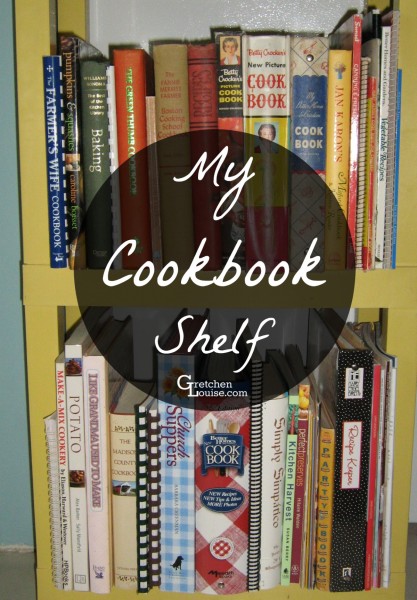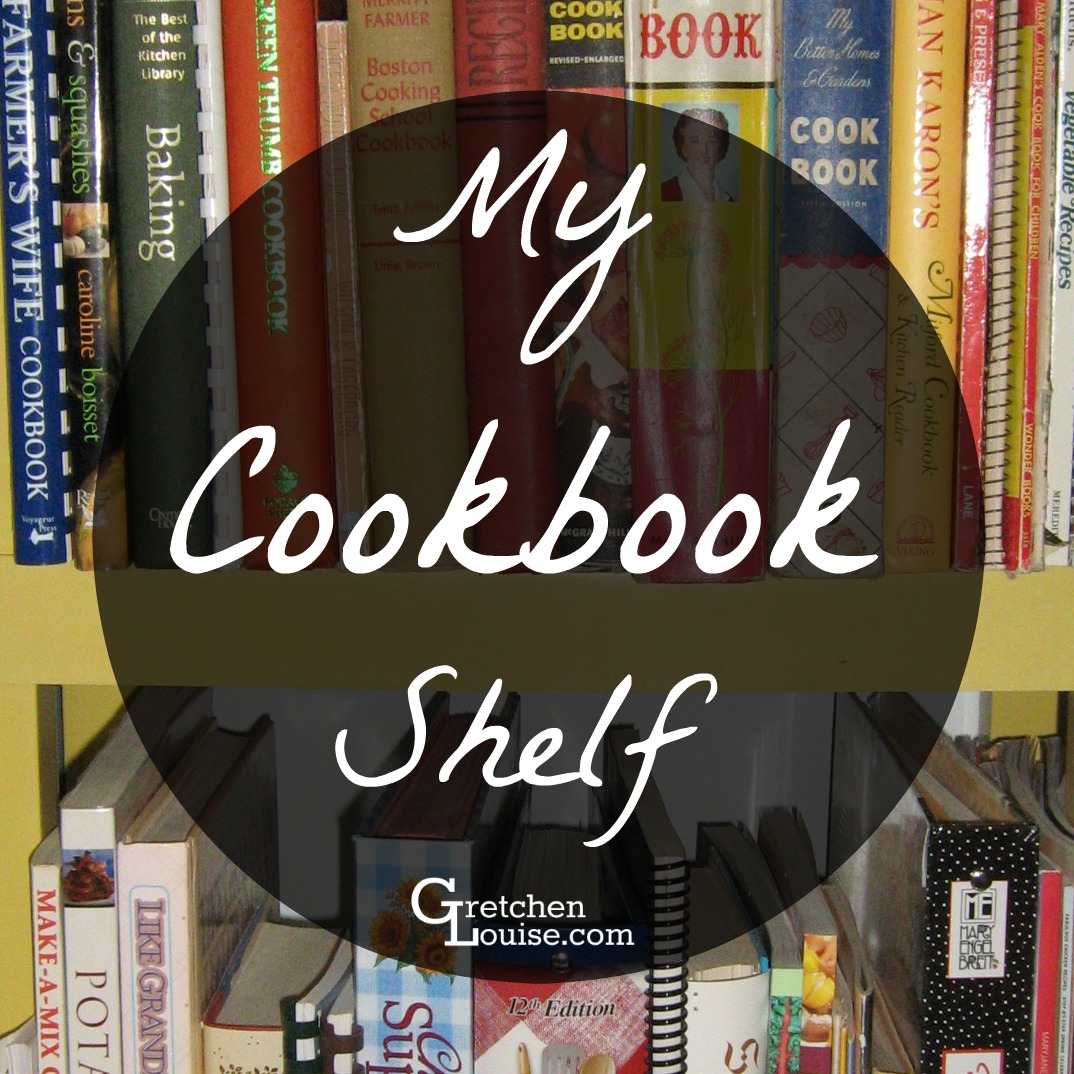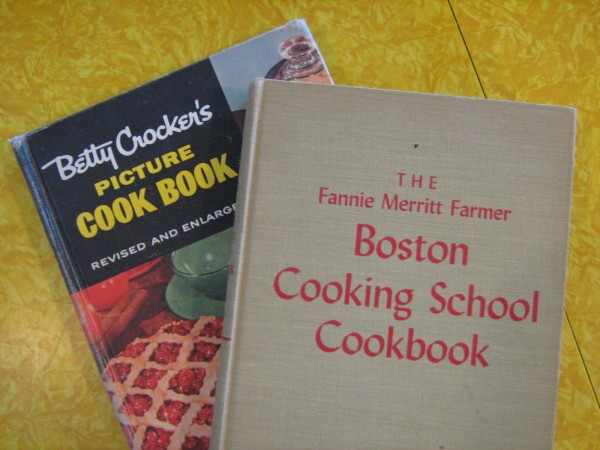My Cookbook Shelf
(This post contains affiliate links. Read my full disclosure.)
“Food prepared with a light heart and in a happy frame of mind is often the best food. Preparing the special foods that are favorites of those you love…making just a little effort to garnish the salad with a sprig of parsley, a bit of grated cheese, or a wild strawberry from the nearby meadow. This says ‘you cared enough to do the little extra things.’ This makes cooking pleasant and satisfying.”
-“Meal Planning,” Betty Crocker’s Picture Cook Book, 1956

Everyone knows that Betty Crocker is the ever-young, ever-fashionable, most versatile cook in the U.S.A. I, however, prefer the vintage 1950’s Betty Crocker, who had just discovered the value of photographs in cook books. Not only does Betty Crocker teach the beginning cook how to do everything from scramble an egg to making a meringue (complete with pictures), as well as set a table and plan a menu, she has so many versatile recipes that even the pro will always be turning back to her pages.
The antique versions of this famous cookbook are best, because back then they knew how to cook from scratch–not from cans and boxes. (See “Recipe for a Good Cookbook“) And what I love about the older versions of Betty Crocker (in addition to the wonderful way it is organized!) are all the key recipes–they tell you how to make a basic recipe, then give you several variations. And once you master the key recipe, of course, you can experiment to your heart’s content. At the moment, I have only two copies: a spiral-bound Betty Crocker’s New Picture Cook Book (first edition, third printing, copyright 1961), and my favorite, a hardbound copy of Betty Crocker’s Picture Cook Book (second edition, second printing, copyright 1956). But being a collector of antiques as well as cook books, I pick up a Betty Crocker whenever I find a good deal, and sometimes I even let one go as a gift to someone I know will appreciate it as much as I did.
I’ll admit the reason I first picked up Fannie Merritt Farmer’s Boston Cooking School Cookbook was because Merritt is the name of the man whose heart I wanted to win (and we all know the way to a man’s heart is through his stomach). But when I finally got my own copy it became an invaluable tool in my kitchen. I like to compare Betty Crocker’s recipes to Fannie Merritt Farmer’s, often ending up with a combination of the two. I’m guessing Fannie Merritt Farmer was the more gourmet of the two back in their day, but either is gourmet compared to today’s home-cooking standards. Fannie Merritt Farmer was apparently the first to bring “level measurements” into popularity–her original cookbook was published in 1896 (mine is the tenth edition, revised by her niece, from 1959). You won’t find photographs in her cook books, but the black and white facts of every culinary art will be a great asset to your cooking.
As you can see, though I have two especial favorites, there are more cookbooks on my shelf…
Back in 1995 my grandparents gave me a Reader’s Digest cookbook called Like Grandma Used to Make. Often as I flip through it, I find the little sheets of menu plans my cousin Melissa and I made up for one of our fancy dinners for the family (which usually turned out to be semi-disasters, with Gretchen making the messes and Melissa following her around with a dish rag). This book is filled with delicious, down-home recipes you’ll always have the ingredients for. It may not have every recipe you’ll ever want to make, but it has a lot you’ll want to try. Whenever I’m lacking creativity, I turn to the pages of Like Grandma Used to Make.
If you’re a working mom or have little time and lots of freezer space, Once a Month Cooking by Wilson and Lagerborg is for you. I used this method for my family when I still lived at my parents’, cooking 30+ meals in one day, and filling the freezer with a variety of menu items that lasted over a month. Now that I’m just cooking for two, I’ve modified the method–I cook lots each meal, and freeze the leftovers for hurried days when I don’t have time to cook.
Make-a-Mix Cookery (by Eliason, Harward, and Westover) is an amazing book I’ve only skimmed the surface of. My mom always made the best pie crusts–straight from this book. The best part was, she made enough dough for 10 pie crusts at a time. Then, when we were ready for a blackberry pie (with berries fresh from the field!), she would take the dough out of the freezer, thaw it, and roll it out. And that’s just the beginning of the mixes you’ll find in the pages of this book!
It took me one look to fall in love with The Farmer’s Wife Cookbook. My grandma gave it to me my first birthday after becoming a farmer’s wife. The redhead waving to the man on the John Deere tractor looked just like us… One of these days, I would love to find an original copy of that issue of The Farmer’s Wife: a magazine for farm women (published from 1893 to 1939). Meanwhile, I enjoy the recipes from the magazine, compiled into a new cookbook by Martha Engstrom. With old advertisements and photos, and original articles from The Farmer’s Wife (such as “Use Butter Generously” and “Why Not Hominy?”), it’s a trip into the history of the farm kitchen. My farmer and I especially enjoyed the article on “Choosing a Refrigerator”, from a 1930 issue of the magazine. It stated that there were really only two or three months out of the year when a refrigerator was necessary, and at least 5 cubic feet of storage space would be a good idea for a family of 4 or 5 (these newlyweds started out with 14.3 cubic feet of refrigerator space, 12 months out of the year!). If you can’t find a vintage Betty Crocker that will fit your budget, The Farmer’s Wife Cook Book will at least give you a flavor of good old-fashioned cooking methods (you might discover some new favorites–like baked custard or rice pudding). (And if you see a copy of the magazine with that tractor cover picture, I want it!)
Church Suppers, coupled with a casserole dish and insulated carrier,was one of the most creative and practical wedding gifts we received. A huge notebook of recipes for church potluck and home alike (by Barbara Greenman). The best thing about it is the selection from across the country–from down-home Southern cooking to a variety of New York cheesecakes.
Better Homes and Garden’s Vegetable Recipes and Rodale Press’ The Green Thumb Cookbook are thrift store finds with recipes organized alphabetically by vegetable–great for fresh ideas for that veggie that’s practically coming out of your ears!
For this winter squash fanatic, Reader’s Digest’s Pumpkins and Squashes by Caroline Boisset was a delightful discovery. There just aren’t enough recipes using squash–but this is a book full of them, as well as pictures and descriptions of all varieties of summer and winter squash.
Williams-Sonoma’s Best of the Kitchen Library: Baking is a bit more on the gourmet side, but any of the cookbooks in this collection are enough to inspire you to new heights. And then there’s Gourmet magazine. It’s a very inexpensive subscription (especially for us because we borrow my sister-in-law’s!), and the magazine is full of mouth-watering recipes. Or, look for Gourmet’s “best of…” recipe book collections on sale. Your cooking will wow your friends. And even if you don’t have all the ingredients each recipe calls for, you can usually figure out a substitute.
Lorenz Books has an amazing line of cook books, too. I only own the Potato book, but it’s true to its name: “the definitive guide to potatoes and potato cooking.” The recipes are gourmet and down-home at the same time. I’m sure I’ll have to pick up another at a garage sale one of these days.
And then there’s the next cook book I’ll buy… Every cook knows she can never have enough cook books. There’s always one more, with yet more recipes to stir your creativity. Like the library’s copy of Ed Wood’s Classic Sourdoughs that is making me want to find its twin for my own.
But enough about cook books. I need to get cooking! I’m making curried carrot soup from Church Suppers to go with the “Lowell Inn Crescent Rolls” from Betty Crocker. And my man will be home for dinner in just a few hours…
“The momentous question of ‘What shall we eat,’ which comes to the housekeeper three times every day and which must be met with a well-supplied table–whether everything else in the house goes undone–becomes monotonous and wearying. We hail suggestions as a ship-wrecked mariner does the distant sail.”
-“Table Talk,” The Farmer’s Wife, May 1912





Anyone know which Betty Crocker cookbook has the Lowell Inn Crescent roll? Year? Printing Edition?
The quote at the end of your post is sooo true! The worst part of cooking is deciding what to serve. Thanks for the cookbook-buying tips! =)
Just wanted to let you know that their are two more farmer’s wife cookbooks. I have one called The Farmer’s Wife Comfort Food Cookbook. The other one is called The Farmer’s Wife Baking Cookbook. All follow the same format. But they don’t all have red-headed farmer’s wives on the covers!
Thank you for sharing, Gretchen! I am going to have to check and see if our library has any of these . . .
Have you heard of the Victory Garden Cookbook? It is one of our favorites! It is divided into chapters for each vegetable and each chapter has information about how to grow vegetables, select ripe ones, and cook them, as well as many different recipes. It’s amazing!
Wow….you could keep me going for a long, long time on all these cookbooks!! I definitely will have a few to add to my “to buy” list of books!! 😉 I love to cook, especially from scratch. What’s the fun of opening a can or a boxed mix? Homemade tastes better, too, if you do it correctly. Thanks for all the tips!!